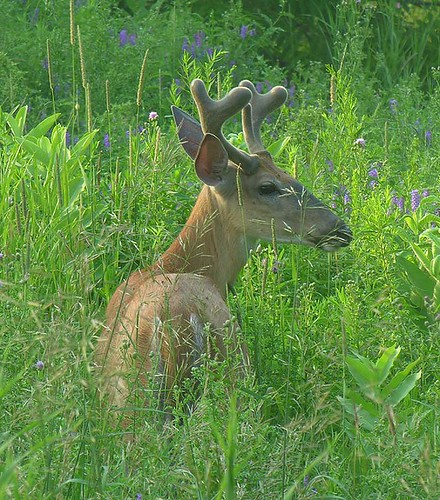White-tailed buck, Odocoileus virginianus,
with velvety antlers photographed through the bedroom
window at the photographer's farm in eastern Ontario.
As you can see, they're not into mowing the lawn around
their house!
Image: Bev Wigney.
Happy Holidays to everyone.
I am receiving so many gorgeous pictures from you, amigos bonitos, and I am overwhelmed by the beauty of these images and the creatures and places depicted. If you have a high-resolution digitized nature image (I prefer JPG format) that you'd like to share with your fellow readers, feel free to email it to me, along with information about the image and how you'd like it to be credited.
.
- Log in to post comments
More like this
White-tailed deer, Odocoileus virginianus, fawn
found sleeping next to a hiking trail at Foley Mountain
near Westport, Ontario.
Image: Bev Wigney.
Happy Holidays to everyone.
I am receiving so many gorgeous pictures from you, amigos bonitos, and I am overwhelmed by the beauty of these images and…
People often send me links to stories of the Indian cow that took to eating baby chickens. The story isn't at all new: it appeared in the press in March 2007, and at least one of the cow's lapses into carnivory was filmed. It's shown here (though see below). As with the epic cat fight, do NOT…
Two white-tailed deer (Odocoileus virginianus) sparring, photographed at a friend's residence in New Jersey.
The skulls of two juvenile, male white-tailed deer (Odocoileus virginianus), photographed at a friend's residence in New Jersey.



Great photo! What a scene to have outside your window.
Is that milkweed? Bev, if you are reading this, do you get monarchs?
What a lovely shot.
Verdure like that must be close to a deer's notion of paradise.
At this stage the antlers look like they could go fork-fork like a mule/blacktail or beam-tine, tine, tine like a whitetail.
It's a strange fact that leg injuries cause antler malformation in several species of deer. For a related interesting, if cruel, experiment check out:
Antler malformation produced by leg injury in white-tailed deer. Oct. 1972. Marburger, R.G., et al. Journal of Wildlife Diseases. 8(4): 311-4.
http://www.jwildlifedis.org/cgi/reprint/8/4/311
Did you know that there are double the number of deer than there were 100 years ago. They have few predators now. One of the biggest problems they face now is a place to live.
Mimi
Many of Utah's deer (yes, I know you're probably thinking of other areas, but nonetheless) herds are overpopulated, and the area's hunters are not active enough to keep them down to size. Yet there's still opposition to bringing back wolves, and opposition to allowing mountain lion or bobcat populations to increase to levels that could have some effect on the deer population problem. So most Utah deer die of starvation.
This is a reply to Torris about the milkweed question up above (sorry not to reply sooner, but I've been busy over the holidays) -- yes, that's Common Milkweed in my garden -- and yes, indeed, we get many Monarchs. This summer, I collected eggs from the leaves and successfully raised, tagged and released almost 50 butterflies. There's quite a bit about the Monarch raising and tagging project on my blog if you're interested in checking it out.